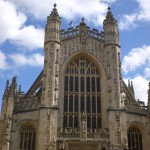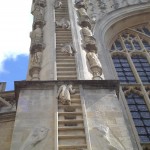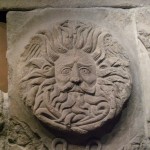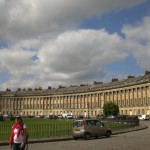August 30th, 2009 · 1 Comment
August 29, 2009
In my last blog, I mentioned how much I didn’t like the Tate Modern. Conversely, but maybe not surprisingly, I LOVED the National Gallery. I was especially excited to see works by Monet, and loved “The Grand Canal, Venice” in particular. Since Van Gogh is one of my favorite artists, I was also amazed to see “Sunflowers” and “A Wheatfield with Cypresses” in person. We continued to wander through rooms containing paintings by Renoir, Picasso, and many artists that I did not recognize (I found some new favorites to look into…Camille Pissarro, for one, who painted “Portrait of Felix Pissarro” and “The Boulevard Montmartre at Night”). I was impressed by the sheer size and detail in many of the paintings, as well as their incredible preservation. I always imagine paintings from so long ago to look old, but these looked as if they were painted yesterday.
The overwhelming majority of the museum’s earliest paintings focused either on mythology or the Virgin Mary/Jesus, and it gave me an idea about just how important these topics were to past generations. Maddie and I discussed how Jesus is almost always interpreted as a tall, thin, fair complexioned man when in reality, he was probably short, squat, curly haired and dark in complexion based on his geographical location. We also thought that “The Virgin and Child before a Firescreen” by a follower of Robert Campin looked almost modern due to how old fashioned it was. It seemed, to us, that art has come full circle in some ways. I was also surprised to stumble upon “The Birth of the Virgin” by Master of the Osservanza, because I’ve never thought or seen record of Mary’s birth. The focus is almost always on the birth of the Christ child, and it was interesting to see another portion of the Biblical story that is entirely overlooked.
Tags: Amy
August 28, 2009 To start, I had my first authentic fish and chips experience in England the other day at a restaurant along the Thames. I’ve found that English restaurants are occasionally difficult to navigate because they’re separated into so many sections depending upon what you want and where you want to eat it. The complication turned out to be entirely worthwhile, though, because the food was delicious! I had no idea that choosing the type of fish is part of the meal (I had haddock). I was quite excited about it, to say the least. After that, we left for the Tate Modern. I normally try to appreciate modern art even if I don’t particularly like it, but I had a hard time enjoying this museum. Perhaps it was my state of mind or tiredness, but I really did not like any of the pieces I saw and couldn’t seem to get any meaning out of them. At one point, we stepped into an exhibit that was marked as containing explicit material. I completely understand that some art is meant to be controversial, but this was legitimately disturbing (I’ll refrain from description in case others haven’t yet seen it). After seeing the video and feeling uneasy, I decided to leave. I’d love to hear what sorts of reactions others had to that exhibit, and what they got out of the museum as a whole because I do feel like I’m missing something.
Tags: Amy
I realized that I forgot to discuss at any length my trip to various art museums in London. So, here is an account of my foray into the wider world of art—according to Britain.

The National Gallery looks out onto Trafalgar Square (find a history of the building here). The building itself is massive and houses thousands of paintings in room after room. The group that I went with found themselves lost in the maze of interconnected rooms. Sure, the collections are divided by period, but when one was distracted by William Turner or Titian, one room seemingly spilled out into the next. Disoriented and confused, it often took several minutes before we could find our way out of the labyrinth.
I should note that we only saw about twenty, maybe thirty, percent of the museum. We were warned that you could spend hours and even days on end in the museum but never truly heeded the warning.
Tired and ragged, we trekked on to the National Portrait Gallery. I should pause for a moment, for I went into this museum with low expectations. I never expected this museum to house any works of art but the typical “woman-seated-staring-at-a-diagonal” type of portrait. Or a bust of an obscure member of Parliament from the 18th century. I did not want to see this, to be honest, because I prefer art with sunlit scenery, some shock value, or images that did not focus solely on human features. I imagined myself walking mindlessly through halls lined with hundreds of identical portraits.
The National Portrait Gallery had all of that, but I’ve never been so wrong about a museum. I found paintings, photographs, busts and other, more abstract, media used to trace the human features of celebrities, average people, and, yes, even obscure members of Parliament. But even the people I did not recognize were immortalized by outstanding and, in many cases, awe-inspiring portraits and sculptures. Take, for instance, one of the paintings submitted to the 2009 BP Portrait Award. They were just incredible (here’s one example). This museum gracefully balanced the shocking and the more tame, the popularized and the relatively obscure. It’s all I ask for in a museum, and something rarely seen in art museums I have seen in the past.
This brings me to the next art museum I visited – the Tate Modern. Again, I think a pause is in order. Having only one course surveying the history of art since the Renaissance, I cannot declare myself all-knowing with regard to art. By the same token, I can appreciate all art. Especially when its definition is psychologically and visually questioned and, in some cases, shattered. I appreciate modern art for this reason; it tacks on an imminent and bold question mark next to the word “art,” and thereby forces us to question the painting/photograph/slideshow/etc. before us. “I could (never) do this” is often heard at these exhibits. As an art history professor explained to me during the course, these people (the Rothkos, Koons, and McCarthys) of the world) DID do it. And that is why it is art. Their expressions of limitless passion and angst and joy spill out into these exhibits, begging for a smiling or a wincing, almost riotous, audience.
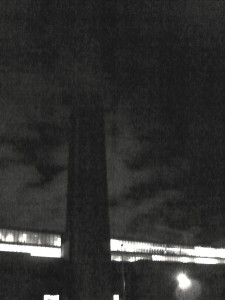
The Tate Modern at night. Disturbingly brooding? Or pleasantly shocking?
Although I have studied art prior to visiting these museums, I looked for a distinctly “English” way of displaying art. Their art included famous works Americans can only view on posters or through a search on the Internet. Moving beyond that initial shock of standing before works including Turner’s “Rain, Steam and Speed”, you can look around and see throngs of art-hungry visitors to the museum. Look closer, and you hear French, Italian, and other languages. Crowds of people from across Europe and, more specifically, England fill the labyrinthine halls. Surely not everyone in London is an art connoisseur, but there’s certainly much diversity to be seen.
Whether you’re revolted or relaxed by the work, at least you had a reaction. Art is universal, it seems, whether you’re in America looking through great art in a book or you’re the very room containing that work.
_____________
If you are interested in some light reading, I suggest an article by Jack Handey in the New Yorker a few years ago. It’s pretty funny and mocks some of the more criticized aspects of modern art.
Tags: Brandon
While going through the British Museum, the National Gallery and the Tate Modern I noticed the lack of British art and artifacts represented throughout these museums. I learned in my Museum Studies class that even major museums in America there are this lack of American artwork in them. Of course this is mainly because America is such a young country and we are beginning to establish our place in the art world just like other older countries have done. Even so, why is Great Britain still under represented, even within their own country?
I began to observe in every major museum in London that I’ve visited to so far this lack of British art. At the National Gallery there were only a few rooms (about 3) dedicated to the country’s artists. For being the “National Gallery” it seemed to be dominated quite a lot by Italian and French artwork. By viewing the layout of the gallery, it is easy to notice the complete lack of British art. It is also noticeable that it is not even the focal point of the museum, but the rooms displaying the artwork are pushed off to the side.
The British Museum also did not live up to its name. Great Britain only had about 4 parts of the entire “British” Museum showing British artifacts, mostly from the Medieval and Roman time periods. The majority of the museum displayed their stolen “acquisitions” from other parts of the world. And still even in this museum Great Britain was not the focal point in the least, for what is one of the first places you see when you walk in but the stolen Egyptian artifacts.
The Tate Modern also did not display many British artists. The gallery seemed to be dominated by American, French and all other countries other than Great Britain. Even America had a much larger place in this museum because of their prominence and prestige amongst the modern and post-modern art world. If you do a quick browse of this museum’s layout, it is easy to see hardly any British artists.
Why I believe there is a general lack of British art and artifacts is because most museums in a large city are meant to show off the prominence and power of that country. In the British Museum, Britain is still shown as a world power and it proudly displays the “booty” they have collected from their conquests of these other countries. Even in the new modern and post-modern art museum, the Tate, these same ideas still play through, just less pronounced than the other two. Museums are still viewed, even in the 21st century, as places of national pride and places to show off your conquests and the “treasures” to the rest of the world.
Tags: Alli · Museums
I can honestly say that the day trip to Stonehenge and Bath was one of the best days of my life. First of all, the weather was fantastic and most of my great days start with great weather. Stonehenge was impressive, and I am truly thankful that we were able to visit, but I’m glad it was only allotted one hour of our time. I was really looking forward to the town of Bath, the home of an extremely well preserved Roman Bathhouse, beautiful Georgian architecture and yet another gorgeous Gothic Abbey. As our bus was winding up and around narrow country roads (and I was praying we didn’t run off them) the town came into view. My jaw dropped. In front of me was what appeared to be the quintessentially English country town…. Complete with Jane Austen! Lunch at the Rat and Parrot pub seemed like a good sign, I’ve never been called “dearie” and “love” more times in an hour than I was there. Walking through the bathhouse with my audio guide I learned about the history of the baths and the bathhouse culture of the Romans. While the museum commentary was informative, I ended up listening to Bill Bryson’s commentary rather than the museum. Bryson has a way of making the simplest truth hilarious. Perhaps it’s the way he phrases things, or maybe it’s the delivery. I still don’t know but I was laughing (and, of course learning) the whole time. The case dedicated to the ‘curses’ was especially hilarious. These little tablets were thrown into the waters as an offering to Minerva in hopes that she would grant what they wished. My favorite was the one about the missing cloak, in which the writer wishes all sorts of injury and ill luck upon the man who robbed him. How could this advanced society, this mighty empire, believe that inscribed tablets to the Gods would help them find their misplaces items? These little curses reminded me of Elementary school threats and superstitions… empty and irrational. “Step on a crack and you’ll break your mother’s back!” although, as a first grader it took me weeks to get over that one. The rest of the day was spent admiring the wonderful Georgian architecture and the Bath Abbey. Just as professor Qualls said, the fan-vaulted ceiling was incredible. The amount of detail that is used in a Gothic church always floors me. I don’t think I would have had the patience to complete it. Some of the most interesting elements were the climbing angel sculptures on the towers. I suppose they are meant to be climbing to heaven. I wanted to climb up there to see a better view of the whole town. I would go back to Bath in a heartbeat, anyone up for a weekend trip when we have time?
From one end of the spectrum to the other… the Tate Modern is the sister museum to the Tate Britain, which houses more ‘traditional’ art on the other side of the river. This old factory and warehouse has certainly retained its origins. The minute you walk in you are overpowered by the sheer space. It’s absolutely huge! Although now that I think about it, it is better to have all that empty space from the ground floor to the ceiling for a large instillation or sculpture. Because of time constraints, I was only able to explore one floor of exhibits. But within those two exhibits I was able to satisfy at small part of my quest to find Modern, British art. What do you think of when you think of British art? I always thought of Gainsboro’s portraits of upper class women in their taffeta gowns against a sweeping background of forest of meadows. Until yesterday I could count the number of British artists I had studied in a Dickinson art history class on my fingers. I was able to see some of my favorites in the abstract expressionism gallery. Kirchner and his take on the classic bathers motif (but with garish coloring and hash angles), Matisse and his simple yet powerful paper cutouts, and Lee Krasner’s Gothic Landscapes. When you research Lee Krasner after reading this, (I am sure most of you have never heard of her) please remember to view her art as a separate entity from her husband’s art…. She was a well-established artist in her own right before they were married. But back to the question, what does the art of a Modern Britain look like? I found a few answers in the Surrealism exhibit. Surrealism is fascinating to me. Not only does it explore the role of the subconscious and dreams, the art tends to pair opposite themes and emotions. Whimsy. Violence. Dark. Light. Primitive. Advanced. My first new artist was Roland Penrose. His piece, Portrait (1937) is a mix of words and images that pushed the boundaries of “acceptable” art out the window. Higher-ups who thought the word “arse” was too foul to use in art removed this piece from display. Little did they know that another one of his pieces used sign language to spell out the word “SHIT.” As I moved in to the Realism section I came into contact with several more new names. Margurite Kelsey, Stanley Spencer and Maraude Gueruarva all painted around 1930. The pieces in the Tate Modern all possess an element of mystery. Kelsey uses such fantastic lighting in her work and the style is almost academic, but at the same time thoroughly modern. Cornelia Parker’s instillation, Thirty Pieces of Silver (1988-9) was my favorite piece of the day. The artists had collected silver object, anything ranging form a teaspoon to a trombone and then had then all rolled over by a steamroller. Most of the items were flattened into wafer-thin version of their original shapes. She then arranged the new forms into disks suspended to the ceiling by thin wire. The effect is almost other-worldly. Looking across the room your eye gets lost in the maze of spider silk like threads sprouting from the ceiling. You follow the threads to the floor and “floating” directly above it– the silver disks. Not only are the disks themselves beautiful to look at, the shadows they cast creates an entirely separate work. I tried to look at the shadows and guess what the object above it was. Sometimes I could tell, other times, not so much. The only thing that could have made this instillation better would be the ability to walk all the way around it. At this time you are limited to two sides. Maybe this is how Parker imagined the instillation… Maybe I can try to find a suggestion box next time I am there.


So what is Modern British art? I don’t know that I have seen enough of a range to give you an answer. I can say that yesterday was an education and an experience. I hope to return to the Tate Modern when I have four or five free hours. I’ll call this the beginning of my quest. What do you think? My time here in London is flying by and each day leads me to see or try something new. I am so thankful for this opportunity.
Tags: Grace
Walking across the Millenium Bridge tonight (well, it was more like jogging to get out stiffness after three hours as a groundling), I was hit by one of those occasional yet profound moments of realization that I was in London. These moments are few and far between, but when you get a moment to step back and look across the Thames and the glowing lights of the city with St. Paul’s dome looming above you, for example, these realizations can hit you like a ton of bricks.
Similar and not unrelated to the “we’re not in Kansas anymore” feelings are the somewhat more frequent instances of understanding the true amount of history behind London and England themselves. In the past few days, I have seen Stonehenge, Roman baths, Medieval cathedrals, prisons, and fortresses, a Shakespeare play, the Jane Austen Centre, the Cabinet War Rooms, and the Tate Modern. The sheer number of years represented by those few landmarks and events is mind-boggling and can serve to disorient the visitor (especially when the visitor comes from a country that’s only approximately 200 years old). I find it interesting to note that I have an almost reverse levels of admiration for the feats and landmarks viewed: I found it utterly astonishing that ancient peoples were able to move stones weighing many tons across empty fields and then arrange them in circular patterns, but I was unimpressed and even disgusted by the artwork of Paul McCarthy digitally projected on a wall with cutting-edge technology at the Tate Modern. I found the stark, bleak nature of the Cabinet War Rooms and the hard work done there to show the strength and resilience of a country under siege, but I found the crown jewels and the grandeur of the monarchy, both past and present, at the Tower of London to be grandiose and over-the-top for a country that is notorious for a “stiff upper lip” and a “keep calm and carry on” sort of mentality.
I suppose what I’m trying to get across is that the sheer nature of hundreds and thousands of years of history (encompassing invasion, multiple great civilizations, and admirable resilience) on a single, small island weighs heavy on a mind that comes from a vast, expansive country with little history at all that can’t even get a healthcare system sorted out. As we now know, you cannot dig down in London without finding something Roman, Medieval, or even prehistoric, yet they still build on and up, layering the present upon the past, and preserving and commemorating as best they can. In my mind, England is a country that seems to be mostly defined by its past, whereas even though America has a shorter history, it seems mostly defined by its present, including its current political standings, fads and trends, and financial influence. London’s ever-changing face and composition always seems to have the same resilient heart, rooted in thousands of years of invasions, shifts in power, influxes of people, devastating disasters, and new technologies, and it appears able to carry on through anything.
Tags: Chelsea · Churches and Cathedrals · Museums
August 28th, 2009 · 1 Comment
After experiencing the National Gallery and the British Museum, the Tate Modern was shocking in and of itself. Compared to the beautiful architecture and classical feel of the other two galleries, the vast emptiness and cold steel of the Tate created an almost uncomfortable feeling. Meant to emphasize the artwork displayed, the white walls and dead space made us feel small.
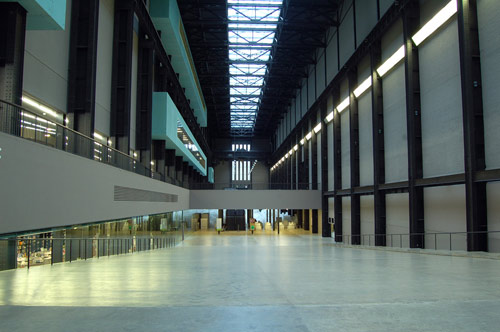
The entrance hall of the Tate Modern
The Tate was also much louder and more family-friendly than the other two museums. Children were sprawled out on the floor and benches, creating their own modern art. Graphic installations were clearly marked by both signs and museum employees. We were impressed by the museum’s effort to be open to all audiences.
Through a combination of choice and naivety, the three of us entered Paul McCarthy’s Projection Room. At first, we were simply disgusted and disturbed by the sexually explicit/grotesque imagery. The videos were so shocking that we can barely even remember what we saw. (For those brave at heart, just google image search “Paul McCarthy” for video examples similar in nature to the exhibit.) A brief peek at the Viennese Actionists exhibit didn’t help to settle our stomachs and minds, so we decided to leave.
Upon returning to the Arran House, we felt obliged to further research McCarthy in attempt to understand the meaning behind his “art.” We discovered he is mocking social rules and standards in addition to the media’s control (read: brainwashing) of our actions. Food and bodily fluid are his medium and his body is used as a paintbrush and a canvas. We found McCarthy views himself as separate from the Viennese Actionists. He states, “Vienna is not Los Angeles. My work came out of kids’ television in Los Angeles. I didn’ t go through Catholicism and World War II as a teenager, I didn’ t live in a European environment. People make references to Viennese art without really questioning the fact that there is a big difference between ketchup and blood. I never thought of my work as shamanistic. My work is more about being a clown than a shaman.”
We’ll leave you with this and let you interpret for yourselves McCarthy’s art and vision.
Tags: Alli · Kelley · Museums · Sarah
Students weren’t the only ones going to markets today. Lest I seem a heartless taskmaster, I set off on my own excursion. With the Victoria line closed today for engineering works (repairs) I took a circuitous route to Brixton. The first thing that struck me was the massive flight of Aussies and Brits from the Oval Tube station for the second day of the 6th test of the Ashes series. My idea of a great day is not sitting in the sun watching “athletes” in sweaters swing a small boat oar at a croquet ball. OK, I just don’t get cricket, but I’m trying. I continued down from the tube by bus to Brixton Market. What a wonder of beautiful color (both skin and fabrics). Brixton is traditionally known as an Afro-Carribean neighborhood, but I think most people would be surprised by the number of Halal butchers and green grocers from the Middle East. The calls of, “Yes, plaintains” with an Arabic accent accompanied the rhythm of reggae beats flowing from the music stalls. After wandering around a bit and running into some of my students next to Windrush Park I found a wonderful organic baker and purchased 1/4 loaves of mango bread and apple/plum/oat bread. After drooling over all the wonderful food I decided to take the first bus I saw and follow it anywhere it went. I ended up at Elephant and Castle (already known as “poop stop” to our group…see the earlier post). I walked from poop stop to Borough Market. What a juxtaposition (and you know I love my juxtapositions) to Brixton. Brixton as a handful of ethno-tourists, but otherwise it is all locals. Borough was nearly all white, seemingly wealthy, and numerous out-of-towners. Whereas Brixton had makeshift kiosks in the middle of lanes and small streets selling DVDs, CDs, cheap clothing and food, Borough Market has posh permanent stalls with overpriced produce, lattes, and gourmet items. Don’t get me wrong, the kangaroo burger I had for lunch was nice, but I should have gone with the jerk chicken. I continued onto to the Thames Walk through Clink, past the even more touristy Globe to Tate Modern (clean bathrooms!) and on to the National Theatre. Here I came full circle. Reggae Magic put on a great free concert as part of the NT’s “Watch tThis Space” series. Except now instead of the beautiful black skin, dreadlocks, and ubiquitous Jamaica shirts (remember, Usain Bolt just won two gold medals and set two world records) at the NT we had a nearly all white crowd that included two pitiful Elvis impersonators (one missing most of his teeth); a half dozen guys in green afro wigs, orange face paint, and white jump suits; and tourists, tourists, and more tourists. The music was fantastic and I found myself smiling for an hour straight. A walk over Hungerford Bridge to Embankment led me back to the hotel.
Such is the beauty of London. A lot of different peoples and places, and there is always something new to try. Music and food just happen to be my obsessions.
Tags: Markets · Professor Qualls



